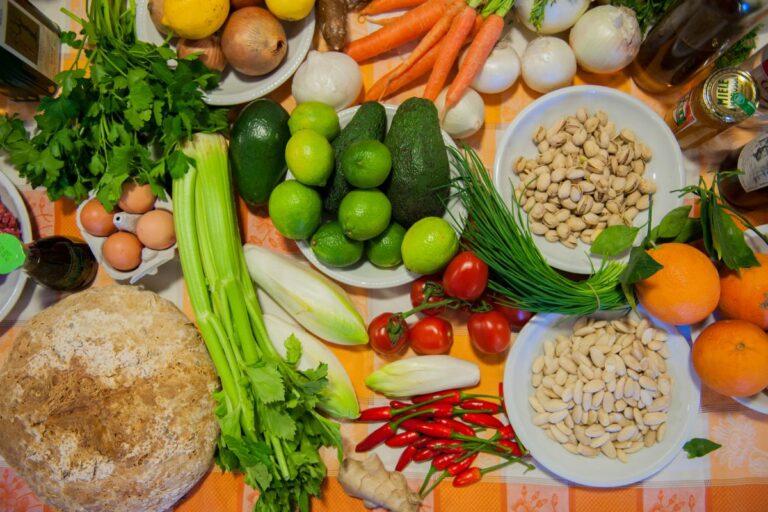What’s the Difference between Kale and Collard Greens?
Looking for healthy superfood, but you wonder about the exact difference between those plants?
No worry, you’ll learn everything in this article.
The main difference between kale and collard greens, is that collar greens are an array of loose leafed plants, which may include kale, a specific plant. Collard greens is a family that also includes plants like bok choy, Brussels sprouts or even cauliflower.
We’ll now dive deeper into the specifics for each plant, and finish by a side-by-side comparison.
Kale
Definition
Also called borecole. a cabbagelike cultivated plant, Brassica oleracea acephala, of the mustard family, having curled or wrinkled leaves: used as a vegetable.
Dictionary
Taste and texture
Kale gets known for its deep green, sometimes with a hint of blue leaves. Kale characteristics include tough curly leaves like you would see in a typical cabbage.
It is nutrition-rich and thick spines. There are two types of kale. Brassica napus and Brassica oleracea. The difference between the two sorts of kale is the texture of the leaves. Brassica napus has more curly or ruffled leaf variety, whilst Brassica oleracea has a smoother leaf texture.

The taste of both kale varieties, like many cabbage related plants, is super robust and very earth-like. The kale leaves doesn’t have any bitter flavour, but the spines or stems are very bitter-tasting and tough. Remove the spines before using kale cooked or raw by cutting along the spine and removing the core.
When it comes to young kale leaves, they are fainter in flavour and are easier to eat by themselves. Kale is also typically eaten raw but also taste great when cooked too.
Health benefits
Kale has many good health benefits for the entire family and should be added to your daily intake one way or another. Some of the astonishing benefits include vitamins and minerals such as potassium, calcium, vitamins A, B, C, and K.
The kale health benefits promotes eye, brain, and bone health. Kale also promotes a healthy immune system to help fight off nasty viruses and flu. Kale can also help aid weight loss, lower your cholesterol, and prevent certain cancers.
Uses
The uses for kale are endless and range from raw to cooked. Some of the ways to use kale include sides, entrees and even mains.
Crispy Kale chips have been a recent and trending way to enjoy this delicious food. Another great way to enjoy kale is in salads. Salads typically used by mainly young, raw leaves. In many restaurants, kale gets often served sautéed or served throughout soup.

The least popular ways a kale getting used is as a filling. Or kale getting used as a bed to catch the juice from roasting a chicken. Or any other type of meat.
Price
In most countries, this delicious and nutritious superfood price has increased by over 25% since 2011.
In Australia, kale is roughly $3-$6 a bunch. Whereas in America, kale gets sold for around $1.50-$3 a bunch.
Collard Greens
Collard refers to certain loose-leafed cultivars of Brassica oleracea, the same species as many common vegetables, including cabbage and broccoli. Collard is a member of the Viridis Group of Brassica oleracea.
Wikipedia
Taste and texture
Collard greens aren’t one particular food. But collard greens are an array of loose leafed plants. These plants may include bok choy, Brussel sprouts, kale and even cauliflower is considered a collard green.
The flavor of collard greens can be summed up in one word: bitter.
Although many collard greens foods have a slightly more toned-down bitter taste than by itself, kale does.
When it comes to the texture of most collard greens, they all have durable leaves. And are equitably water-resistant. The collard green leaves change in texture once the heat gets added to them. They often soften and become less chewy.
Health benefits
Collard greens fall in tenth place of the world’s best superfoods and should definitely be added to your food diet one way or another. Not only is collard greens classed as a super healthy food and can help with weight loss, but it can also help improve your current way of living and eating.
Collard greens have a healthy amount of magnesium, thiamine, calcium, and many vitamins such as vitamin K, A, B-6, and C.
Uses
There are hundreds of ways to use collard greens and all of which are better than the next. Some great ways to utilise this food group is blanching or steaming them.
Collard greens used in soups are another popular and delicious way to use all of the food. Stir-frying is also another good way that collard greens can get prepared, and lastly, used within salad and slaws.
Price
Collard greens are specifically cheaper than most vegetables out there. Collard greens typically have remained around the same price throughout time. Collard greens are roughly $1-$3 a bunch.
DIFFERENCE BETWEEN KALE AND COLLARD GREENS
Taste and texture
There isn’t much difference, and often times, kale can be classed as a collared green food because kale does share a relationship with the cabbage family Brassica oleracea. The difference between the texture of kale and collard greens is that kale often has curly or smooth leaves, whereas many collard greens food has soft leaves.
As for the texture, the kale spine is pretty much edible. As kale is so bitter. Whereas. Collard greens are slightly more manageable to eat.
Health benefits
When it comes down to the health benefits differences, this too. Like the taste and texture isn’t much of a sizeable difference. Kale and collard greens both share the exact number of vitamins. And this includes vitamins such as vitamins A, B, C, and K.
The only sizeable difference between the two vegetable categories is that kale contains more iron, and collard greens contain more fiber and protein.
Uses
The uses of the vegetables from the Brassica oleracea groups is the same. Both foods can get used in the same methods of cooking. But you’ll find that collard greens are often preferred to be cooked, whereas kale gets often used raw.
Price
The price difference between kale and collard greens are too extensive nor far apart from each other. Kale gets considered to be more valuable to consumers and retailers. And that’s why kale is more costly than collard greens.
| Kale | Collard greens | |
| Taste | Extremely bitter spines, robust earthy flavour | Bitter-sweet |
| Texture | Tough leaves, slightly waterproof, smooth, or curly leaves | Tough leaves, durable and waterproof, very soft leaves |
| Health Benefits | Vitamins A, B, C, K. High source of Iron High source of potassium | Vitamins A, B, C, K High in fibre Good source of protein |
| Uses | Sauteing Crispy chips Snack Side dish Main dish Salads Soups Steams or stir-fry | Sauteing Side dish Main dish Soups Salads and slaws Steams or blanching Stir-fry |
| Price | $3 – $6 | $1 – $3 |






